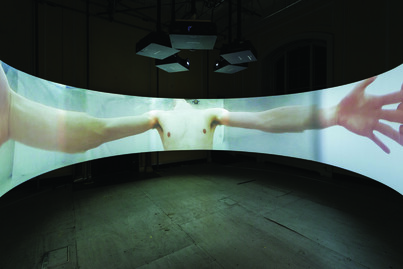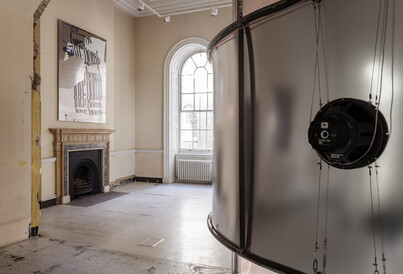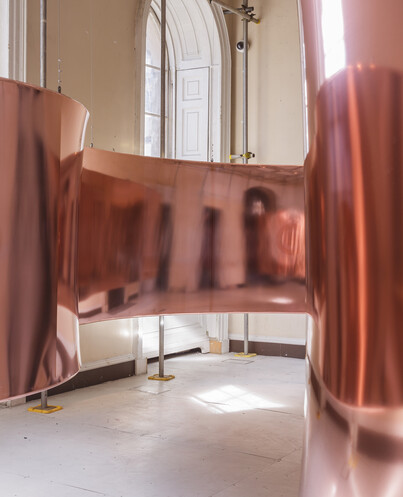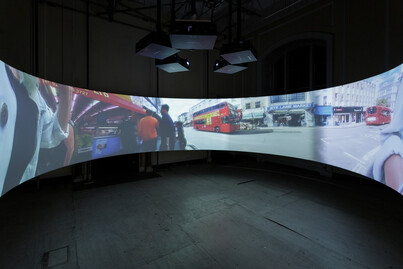Hannah Perry
by Amie Corry
Reviews /
Exhibition
• 10.12.2018
The success of GUSH – Hannah Perry’s first exhibition in the United Kingdom since 2015 – relies on a single work: a five-channel audio-video installation, which, following its display in London at Somerset House Studios has been recast in virtual reality for Towner Art Gallery, Eastbourne. And succeed GUSH does, the stark unabashed emotion it displays belying its complexity.
GUSH – the title of the video as well as the show – requires close, urgent involvement. Its success is largely attributable to Perry’s beautifully patched-together observations of both contemporaneity and masculinity – their trappings and frailties – at a time when we are desperately scrabbling around for workable, and palatable, definitions of both. GUSH's potency also relates to its autobiographical nature, through which it explores what the personal, or more accurately the self, now means. This is framed by Perry’s need to make sense of the will to destroy the self, as her friend and collaborator Pete Morrow did in 2016; one of 5,965 people who killed themselves in the United Kingdom that year, three-quarters of whom identified as male.1
At Somerset House Studios, where Perry is now in residence, three supporting pieces were displayed in the galleries leading to the cavernous pitch-black space in which the 360-degree GUSH loops FIG.1. A pair of screenprinted aluminium wall pieces – Like Hell and Love Bomb FIG.2 – bear irregular splinters of vinyl car wrap, which cut into and distort a collage of words. The slivers of text hint at the beguilingly naive, diaristic deployment of language that works so powerfully in the video: ‘sex dreams in which I am perfect’, ‘cry daggers’, ‘robotic purpose’. If anything, the two-dimensional pieces feel a little tacked on, but they nod at themes – mediated language, distorted perceptions, the manipulation and trauma of materials – that recur throughout this body of work.
The inclusion of one of Perry’s signature Rage Fluids sculptures – which snakes its way through the faded, corniced rooms of Somerset House FIG.3 and fills the gallery space at Towner – helps to bring out subtler aspects of the video. Car body wrap recurs here, reminding the visitor that Perry’s medium is also her message. Sheets of the reflective rose-gold wrap are stretched over steel frames that hang a metre or so off the ground. A series of sleek subwoofers emitting low frequency pulses of bass are affixed to one side of its surface FIG.4. The sound causes the wrap, and the viewer's reflection with it FIG.5, to breath, shiver and judder. It is deeply sexy. It is also knowing, inviting contemplation of the physical limits of our bodies, the impact of shock.
Crucially, the car wrap evokes the armour of modern masculinity. Perry comes from a family of welders and the automobile is her fetish object, her model of masculinity. This brings to mind J.G. Ballard’s protagonist in Crash (1973): ‘Vaughan propped the cine-camera against the rim of the steering wheel. He lounged back, legs apart, one hand adjusting his heavy groin. The whiteness of his arms and chest, and the scars that marked his skin like my own, gave his body an unhealthy and metallic sheen, like the worn vinyl of the car interior’.2 In Perry’s work, by way of contrast, the machine is less a stand-in for the body and its desires, and more an expression of a costume proven to be impractically rigid, and thus frail. There is something touching, even delicate, about the car wrap, a quality that also clings to a bit of footage of a scrap yard in GUSH. This is not caricature, it is a nod to the necessary accoutrements of a certain sort of maleness, the foundations of which are unsteady, often harmful. As Perry notes: ‘There is a dominant ideology that favours men, but it is to their detriment if they’re not able to be perceived as vulnerable’.3
GUSH ebbs, flows and eventually consumes its viewers. It is a rhythmic and then emotional sort of consumption that easily warrants the video's twenty-minute course. Any notion of real time, so key to the inception of video art in the 1960s and 1970s, is abandoned and the result is something more akin to episodic memory or dream. Footage of the oscillating flesh of dancers, naked or clothed in flesh-toned futuristic costume, is spliced with scenes taken from a span of years, platforms and locations: Peckham streets FIG.6, Los Angeles, Perry’s flat, Skype, diary entries, social media posts, texts. Spoken, sung and written word underpins the film FIG.7 – much of it deriving from Morrow’s diaries or correspondence, as well as from workshops Perry conducted with south London college students. The exquisite score, meanwhile, was composed with the London Contemporary Orchestra, Mica Levi and Coby Sey: Perry read from Morrow’s diaries and the musicians responded instinctively to the words, a nod to the central importance of collaboration to the GUSH project.
The clamorous immediacy of GUSH relates less, then, to any grounded sense of person, time or place and more to an onslaught of activity and noise that characterises life in a hypermediated world. Words jump and bounce: ‘A rattling bag of bones / a rattling bag of stones [. . .] not a bad bone in your body [. . .] a body blow / body: the main section of a motor vehicle’. Meanwhile, the dancers – who feature in the visceral live performance piece that accompanies the project – operate from an otherworldly set, shot through a custom-rigged camera installed within a transparent pole-dancing pole. The effect is a sort of external endoscopy.
In her 1976 essay ‘Video: the Aesthetics of Narcissism’, Rosalind Krauss argued that ‘Video’s real medium is the psychological situation, the very terms of which are to withdraw attention from an external object – an Other – and invest it in the self’.4 Krauss’s argument is too narrow, but it is relevant here. In GUSH, Perry’s self manifests through an undefined cast of words, images and people. This hints at how the self is defined in relation to others and thus the difficulty of coming to terms with the loss of an other.
What does the act of suicide actually do, Perry seems to be asking. As Siri Hustvedt notes in ‘Suicide and the Drama of Self-Consciousness’: ‘There is no consensus about what a self is. Its contours change or even vanish depending on your particular perspective – philosophical, psychological, or neurobiological’.5 Despite the huge wealth of studies into the genetic and neurochemical contributors to suicide, thinking about it is an essentially subjective experience, which relates to how we conceive ourselves. And this is what GUSH gets at so successfully. Here, the experience is Perry’s, yet it is tangled with Morrow’s, perhaps yours; it is levelling despite its specificity.
Although devastating, GUSH feels optimistic, or at least forward-looking, because Perry’s emphasis on collaborative modes of working, and the results of those modes, urges discussion, openness, the dispelling of stigmas and the re-evaluation of structures proven to be unworkable in their inflexibility.










